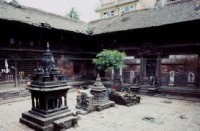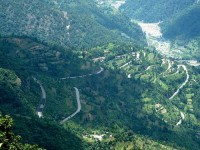Top ten Temples of Nepal
Nepal is rich in religious as well as cultural heritage. It is often called the home of Gods and Goddesses. Many national and international pilgrims find their way to some of the major religious sites of Nepal. The list of top ten temples of Nepal is given below.
10. Bajrayogini
The three-storied temple at the shore of Sali River in Sankhu, in the Kathmandu Valley, is one of the top ten temples in Nepal. The statue of the Goddess is adorned in heavy ornaments and it also a proof of existence of Buddhism in Nepal from around the first century. Thus, it has religious significance to both, the Hindu and the Buddhists.
9. Dantakali
Legend says that a tooth of Sati Devi fell here when Shiva was carrying her death body and roaming in agony. Hence, it got its name Dantakali, ‘Danta’ meaning ‘teeth’ and ‘Kali‘ a form of ‘Sati‘. Agonized by her death, lord Shiva carried her deceased body around his shoulder and wherever the parts of her body fell, today there stands some great temples. It is situated in the middle of Hilchowk of Vijaypur in Dharan.
8. Changunarayan Temple
A fine example of Nepalese medieval architecture, Changunarayan is marked as one of the UNESCO World Heritage site. Situated around 8 miles east of Kathmandu, in Bhaktapur, the temple of Lord Bishnu holds great historical and religious importance in Hindu Culture. The legend says that he was accidently freed from his curse by two humans believing him to be a devil cutting down the tree.
7. Dakshinkali
Devoted to the most feared goddess Kali, the Dakshinkali temple is located 14 miles south of the Kathmandu. It is believed that the goddess city from the south (Dakshin). As the legend goes, the Goddess herself appeared in the Dream of the then King and demanded a temple to be built in that direction where her statue was found.
6. Varaha Kchetra
Situated in the east of Nepal at the convergence of the Sapta Koshi and Koka rivers, Varaha Kchetra is considered as one of the most holy pilgrimage in Nepal. The fifth century statues welcome the pilgrims to the stone of sin. It is believed that whoever can lift the stone is set to be free of their sins. The legend says that Lord Bishnu took the form of a white boar to bring the world from the bottom of the cosmic ocean after his victory with a demon named Hiranyaksha.
5. Budanilkantha
Situated at the bottom of the Shivapuri Mountain, 8km from the capital reclining on the coils of a cosmic 11 hoofed serpents over a natural spring is a five meter big carving of Lord Bishnu. As the legend goes, it is believed that the statue was discovered by a farmer ploughing his field who accidently cut of a thumb from the sculpture and it started bleeding. The Royals were restricted from viewing it for some divine power preventing it to happen every time they attempted. And it was said that the King would die instantly if he ever tried viewing it. Thus, a small replica of the sculpture was made in Balaju for the Royal Family.
4. Swayambhunath Stupa
It is one of the oldest religious sites of Nepal that holds great respect for Hindu and Buddhist religion. It is also known as Monkey Temple for the monkeys that inhabit there. It is believed that the place was once filled with water where an enormous lotus grew. It got its name since it was built over a self-existent eternal flame. The stupa consists of a dome at its base above which a cubical structure is painted with eyes of Buddha looking in all four directions and at the base, there are five massive golden statues of Buddha. It is a fine example of architecture that proudly stands 365 steep steps above the surface.
3. Manakamana
The goddess is named Manakamana because she is believed to fulfill the wishes of the people. It has its own share of mystery as any other Hindu temple. It is said that it was build where a farmer accidently hit a stone and blood and milk came out of it. Later it was declared as the reincarnation of a Goddess and built into a grand temple. It is located 105 km from Kathmandu. It is easily accessible by Cable car these days. However, one could trek for a couple of hours to reach the temple.
2. Muktinath
It is situated at an altitude of 3,710m at the foot of the mountain Thorong La Mountain in Mustang district. It is one of the biggest religious and tourist destinations of the country. It holds significance for both the Hindu and Buddhists. The pilgrims take upon the challenges of the treacherous and rough paths in search of Salvation (Mukti).
- Pashupatinath
It is the most significant Hindu temple of Lord Shiva in the world. It means the ‘Lord of the Animals’ and is populated by monkeys who live in harmony with the locals. It is also one of the UNESCO World Heritage Sites. It is situated in the banks of Bagmati River. It is one of the Paadal Petra Sthalams (holy abodes of Shiva) on the continent. Only Hindus are allowed to enter the temple premises while others can only observe from the other bank of the river. The most thrilling mystery surrounding the area is of Kali, the biggest sinner who married his own mother and thus cursed by gods to remain as a stone underneath the surface. It is believed that the statue rises from the ground as the sins in the world increase and the world will come to an end once it fully surfaces.







